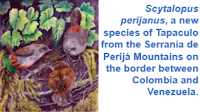Ovenbirds, Furnariidae, are a group of small-to-medium sized Passarine Birds distributed from Mexico to the southernmost islands of South America (the North American Ovenbird, Seiurus aurocapilla, is not actually a true Ovenbird), which get their name from their construction of elaborate clay nests by some members of the group - although most species do not actually do this.
The genus Aphrastura contains two species of South American Overnbirds known colloquially as Rayaditos. The Thorn-tailed Rayadito, Aphrastura spinicauda, is found in temperate forests from north-central Chile to the islands off the southern tip of South America, while the Masafuera Rayadito, Aphrastura masafuerae, is found only in the misty Tree Fern forests of the remote Alejandro Selkirk Island, 670 km off the west coast of Chile.
The southernmost population assigned to Aphrastura spinicauda is found in the Diego Ramírez Archipelago, a group of continental islands forming the southernmost part of South America, separated from Cape Horn by the 100 km wide Drake Passage. The Diego Ramírez Archipelago is a group of small islands, rocks, and reefs, with a total exposed area of about 79 km². None of the islands there have any trees, let alone forests, the islands are constantly buffered by strong winds, average annual rainfall is about 1500 mm, distributed throughout the year, with annual temperatures being 5.6°C, falling to 3.3°C in the coolest month (August) and rising to 7.5°C in the warmest month (March).
Despite this apparently hostile environment, the second largest landmass in the group, Gonzalo Island, which is covered entirely by Tussock Grass, Poa flabellata, and otherwise populated only by burrow-nesting Seabirds, hosts a population of Rayaditos, birds otherwise known only from dense forest interiors, which otherwise are usually reluctant to cross wooded scrublands and never found in open environments.
In a paper published in the journal Scientific Reports on 26 August 2022, a team of scientists led by Riccardo Rozzi of the Cape Horn International Center of the Universidad de Magallanes, and the Sub-Antarctic Biocultural Conservation Program, Department of Philosophy and Religion and Department of Biological Sciences at the University of North Texas, examine the Gonzalo Island population of Aphrastura, looking at its ecology and genetic heritage, and formally describe it as a new species.
Genetic analysis of DNA obtained from blood samples has already proven a useful tool in the study of the genus Aphrastura, establishing that populations of Aphrastura spinicauda found on Chiloé Island, the Chonos Archipelago, and on Mocha Island, all off the west coast of Chile, are genetically distinct enough to be classified as different subspecies.
Applying the same methodology to the Gonzalo Island population, Rozzi et al. found that the population was significantly diverged from other populations assigned to Aphrastura spinicauda, and that there were no signs of ongoing interbreeding between the Gonzalo Island population and any other population, including other populations on islands off the southern coast of South America.
Based upon this conclusion, Rozzi et al. describe this population as a new species, which they name Aphrastura subantarctica, in reference to its distribution, being found only on a remote, Subantarctic Island. Morphologically, this species resembles other species of Aphrastura, most notably in sharing their distinctive thornlike tail-feathers, but has a larger body, larger beak, larger tarsus (lower leg), and shorter tail than other members of the genus.
Other members of the genus Aphrastura typically nest in holes in trees. However, trees are entirely absent on Gonzalo Island, and the dominant form of vegetation, Tussock Grass, offers no equivalent nesting spaces. Observation of the nesting behaviour of Aphrastura subantarctica on Gonzalo Island found that about half of nesting sites were on the ground, in locations sheltered by Tussock Grasses or geographical features, while the remainder were in burrows abandoned by nesting Seabirds or natural soil cavities.
The adult Birds typically forage for invertebrates on the ground no more than 20-30 m from the nest, and fly less often, and lower, than other members of the genus. Both increased body-size and reduced flying compared to close relatives are common in Bird species inhabiting small islands, and are considered to be adaptations to living in environments where being swept out to sea by high winds is a more serious threat than predation, something certainly true for the Aphrastura population on Gonzalo Island.
Gonzalo Island is more than 100 km from its nearest neighbour, Horn Island, a distance probably impossible for any member of the genus Aphrastura to cross, particularly given the prevalent high winds in the area. Rozzi et al. suggest that these Birds probably reached the island during the Last Glacial Maximum, between 28 000 and 18 000 years ago, when lower sea levels would have meant the islands would have been larger, possibly with now submerged smaller islands between, enabling a small population to reach the new environment.
See also...







